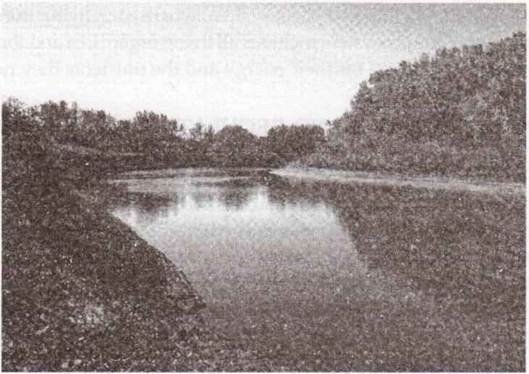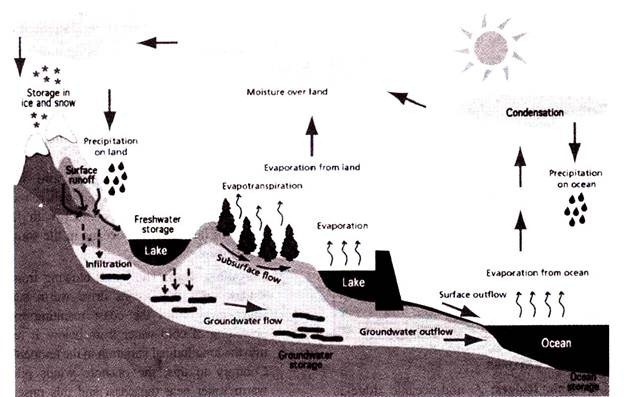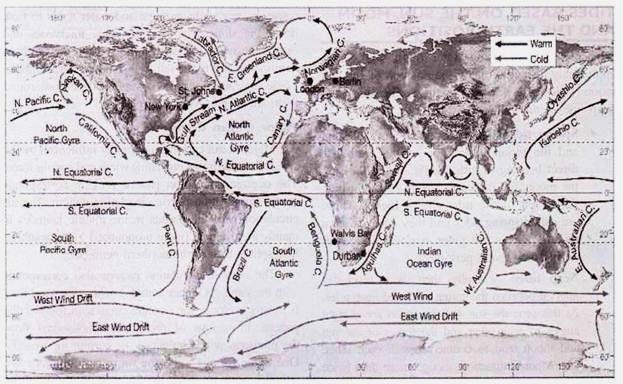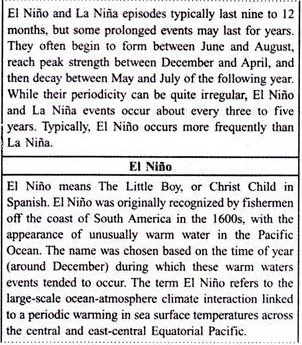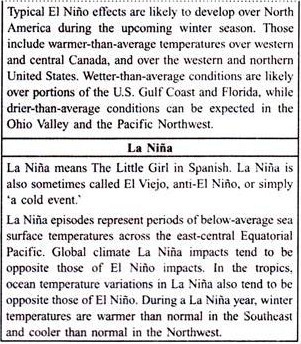ADVERTISEMENTS:
Hydrosphere Essay – This is one of the best essays on ‘Hydrosphere’ especially written for school and college students.
Essay on the Hydrosphere
ADVERTISEMENTS:
Essay Contents:
- Essay on the Introduction of Hydrosphere
- Essay on the Hydrological Cycle
- Essay on Ocean Floor
- Essay on Ocean Water
- Essay on Ocean Currents
Essay # 1. Introduction of Hydrosphere:
The hydrosphere is the liquid water component of the Earth. It includes the oceans, seas, lakes, ponds, rivers and streams. The hydrosphere covers about 70% of the surface of the Earth and is the home for many plants and animals.
The hydrosphere, like the atmosphere, is always in motion. The motion of rivers and streams can be easily seen, while the motion of the water within lakes and ponds is less obvious. Some of the motion of the oceans and seas can be easily seen while the large scale motions that move water great distances such as between the tropics and poles or between continents are more difficult to see.
These types of motions are in the form of currents that move the warm waters in the tropics toward the poles, and colder water from the Polar Regions toward the tropics. These currents exist on the surface of the ocean and at great depths in the ocean (up to about 4km).
ADVERTISEMENTS:
The characteristics of the ocean which affects its motion are its temperature and salinity. Warm water is less dense or lighter and therefore tends to move up toward the surface, while colder water is more dense or heavier and therefore tends to sink toward the bottom.
Salty water is also more dense or heavier and thus tends to sink, while fresh or less salty water is less dense or lighter and thus tends to rise toward the surface. The combination of the water’s temperature and salinity determines whether it rises to the surface, sinks to the bottom or stays at some intermediate depth.
The oceans currents are also affected by the motion of the atmosphere, or winds, above it. The energy in the wind gets transferred to the ocean at the ocean surface affecting the motion of the water there. The effect of wind is largest at the ocean surface.
ADVERTISEMENTS:
The ocean serves two main purposes in the climate system. First, it is a large reservoir of chemicals that can contribute to the greenhouse effect in the atmosphere and energy absorbing 90% of the solar radiation which hits the surface. This reservoir changes very slowly limiting how fast the climate can change. Second, it works with the atmosphere to redistribute the energy received from the sun such that the heat in the topics, where a lot of energy is received from the sun, is transferred toward the poles, where heat is generally lost to space.
Essay # 2. Hydrological Cycle:
Water is a cyclic resource. It can be used and reused. Water also undergoes a cycle from the ocean to land and land to ocean. The hydrological cycle describes the movement of water on, in, and above the earth. About 71 per cent of the planetary water is found in the oceans. The remaining is held as freshwater in glaciers and icecaps, groundwater sources, lakes, soil moisture, atmosphere, streams and within life.
Nearly 59 per cent of the water that falls on land returns to the atmosphere through evaporation from the oceans as well as from other places. The remainder runs-off on the surface, infiltrates into the ground or a part of it becomes glacier.
Essay # 3. Ocean Floor:
The geographers have divided the oceanic part of the earth into four oceans, namely the Pacific, the Atlantic, the Indian and the Arctic. The various seas, bays, gulfs and other inlets are parts of these four large oceans. A major portion of the ocean floor is found between 3-6 km below the sea level.
i. Mid-Oceanic Ridges:
A mid-oceanic ridge is composed of two chains of mountains separated by a large depression. Iceland, a part of the mid-Atlantic Ridge, is an example.
ii. Seamount:
It is a mountain with pointed summits, rising from the seafloor that does not reach the surface of the ocean. Seamounts are volcanic in origin. The Emperor seamount, an extension of the Hawaiian Islands in the Pacific Ocean, is a good example.
ADVERTISEMENTS:
iii. Submarine Canyons:
These are deep valleys, some comparable to the Grand Canyon of the Colorado river. They are sometimes found cutting across the continental shelves and slopes, often extending from the mouths of large rivers. The Hudson Canyon is the best known canyon in the world.
iv. Guyots:
It is a flat topped seamount. They show evidences of gradual subsidence through stages to become flat topped submerged mountains. It is estimated that more than 10,000 seamounts and guyots exist in the Pacific Ocean alone.
v. Atoll:
These are low islands found in the tropical oceans consisting of coral reefs surrounding a central depression.
Divisions of the Ocean Floors:
The ocean floors can be divided into four major divisions:
(i) The Continental Shelf;
(ii) The Continental Slope;
(iii) The Deep Sea Plain;
(iv) The Oceanic Deeps.
(i) Continental Shelf:
The continental shelf is the extended margin of each continent occupied by relatively shallow seas and gulfs. It is the shallowest part of the ocean showing an average gradient of 1° or even less. The shelf typically ends at a very steep slope, called the shelf break.
The Siberian shelf in the Arctic Ocean is the largest in the world, stretches to 1,500 km in width. Massive sedimentary deposits received over a long time by the continental shelves, become the source of fossil fuels.
(ii) Continental Slope:
The continental slope connects the continental shelf and the ocean basins. It begins where the bottom of the continental shelf sharply drops off into a steep slope. The slope boundary indicates the end of the continents. Canyons and trenches are observed in this region.
(iii) Deep Sea Plain:
Deep sea plains are gently sloping areas of the ocean basins. These are the flattest and smoothest regions of the world. These plains are covered with fine-grained sediments like clay and silt.
(iv) Oceanic Deeps or Trenches:
These areas are the deepest parts of the oceans. The trenches are relatively steep sided narrow basins. They occur at the bases of continental slopes and along island arcs and are associated with active volcanoes and strong earthquakes. That is why they are very significant in the study of plate movements.
Essay # 4. Ocean Water:
Temperature of Ocean Waters:
Ocean waters get heated up by the solar energy just as land. The process of heating and cooling of the ocean water is slower than land.
Factors Affecting Temperature Distribution:
The factors which affect the distribution of temperature of ocean water are:
i. Latitude:
The temperature of surface water decreases from the equator towards the poles because the amount of insolation decreases pole ward.
ii. Unequal Distribution of Land and Water:
The oceans in the northern hemisphere receive more heat due to their contact with larger extent of land than the oceans in the southern hemisphere.
iii. Prevailing Wind:
The winds blowing from the land towards the oceans drive warm surface water away from the coast resulting in the upwelling of cold water from below. It results into the longitudinal variation in the temperature. Contrary to this, the onshore winds pile up warm water near the coast and this raises the temperature.
iv. Ocean Currents:
Warm ocean currents raise the temperature in cold areas while the cold currents decrease the temperature in warm ocean areas. Gulf stream (warm current) raises the temperature near the eastern coast of North America and the West Coast of Europe while the Labrador current (cold current) lowers the temperature near the north-east coast of North America. The enclosed seas in the low latitudes record relatively higher temperature than the open seas; whereas the enclosed seas in the high latitudes have lower temperature than the open seas.
Horizontal and Vertical Distribution of Temperature:
The boundary region, from where there is a rapid decrease of temperature, is called the thermocline. About 90 per cent of the total volume of water is found below the thermocline in the deep ocean. In this zone, temperatures approaches 0°C. The temperature structure of oceans over middle and low latitudes can be described as a three-layer system from the surface to the bottom.
The first layer represents the top layer of warm oceanic water and it is about 500 m thick with temperatures ranging between 20° and 25°C. This layer, within the tropical region, is present throughout the year but in mid latitudes it develops only during summer. The second layer called the thermocline layer lies below the first layer and is characterized by rapid decrease in temperature with increasing depth. The thermocline is 500-1,000 m thick.
The third layer is very cold and extends up to the deep ocean floor. In the Arctic and Antarctic circles, the surface water temperatures are close to 0°C and so the temperature change with the depth is very slight. Here, only one layer of cold water exists, which extends from surface to deep ocean floor. The average temperature of surface water of the oceans is about 27°C and it gradually decreases from the equator towards the poles.
Salinity of Ocean Waters:
Salinity is the term used to define the total content of dissolved salts in sea water. It is calculated as the amount of salt (in gm) dissolved in 1,000 gm (1 kg) of seawater. It is usually expressed as parts per thousand (%) or ppt. Salinity is an important property of sea water. Salinity of 24.7% has been considered as the upper limit to demarcate ‘brackish water’.
Factors affecting ocean salinity are mentioned below:
1. The salinity of water in the surface layer of oceans depends mainly on evaporation and precipitation.
2. Surface salinity is greatly influenced in coastal regions by the fresh water flow from rivers, and in polar regions by the processes of freezing and thawing of ice.
3. Wind also influences salinity of an area by transferring water to other areas.
4. The ocean currents contribute to the salinity variations. Salinity, temperature and density of water are interrelated. Hence, any change in the temperature or density influences the salinity of an area.
Horizontal Distribution of Salinity:
The salinity for normal open ocean ranges between 33% and 37%. In the landlocked Red Sea, it is as high as 41%, while in the estuaries and the Arctic, the salinity fluctuates from 0-35%, seasonally. In hot and dry regions, where evaporation is high, the salinity sometimes reaches to 70%.
The North Sea, in spite of its location in higher latitudes, records higher salinity due to more saline water brought by the North Atlantic Drift. Baltic Sea records low salinity due to influx of river waters in large quantity. The Mediterranean Sea records higher salinity due to evaporation.
Salinity is, however, very low in Black Sea due to enormous fresh water influx by rivers. The average salinity of the Indian Ocean is 35%. The low salinity trend is observed in the Bay of Bengal due to influx of river water by the river Ganga. On the contrary, the Arabian Sea shows higher salinity due to high evaporation and low influx of fresh water.
Vertical Distribution of Salinity:
Salinity at the surface increases by the loss of water to ice or evaporation, or decreased by the input of fresh waters, such as from the rivers. Salinity at depth is very much fixed, because there is no way that water is ‘lost’, or the salt is ‘added.’ The lower salinity water rests above the higher salinity dense water. Salinity, generally, increases with depth and there is a distinct zone called the halocline, where salinity increases sharply.
High salinity seawater, generally, sinks below the lower salinity water. This leads to stratification by salinity.
Movements of Ocean Water:
The horizontal and vertical motions are common in ocean water bodies. The horizontal motion refers to the ocean currents and waves. The vertical motion refers to tides.
i. Waves:
Waves are actually the energy, not the water as such, which moves across the ocean surface. Water particles only travel in a small circle as a wave passes. Wind provides energy to the waves. Wind causes waves to travel in the ocean and the energy is released on shorelines. As a wave approaches the beach, it slows down.
This is due to the friction occurring between the dynamic water and the sea floor. And, when the depth of water is less than half the wavelength of the wave, the wave breaks. The largest waves are found in the open oceans.
Waves continue to grow larger as they move and absorb energy from the wind. Most of the waves are caused by the wind driving against water. When a breeze of two knots or less blows over calm water, small ripples are formed and grow as the wind speed increases until white caps appear in the breaking waves.
A wave’s size and shape reveal its origin. Steep waves are fairly young ones and are probably formed by local wind. Slow and steady waves originate from faraway places, possibly from another hemisphere. The maximum wave height is determined by the strength of the wind i.e. how long it blows and the area over which it blows in a single direction. Waves travel because wind pushes the water body in its course while gravity pulls the crests of the waves downward.
ii. Tides:
The periodical rise and fall of the sea level, once or twice a day, mainly due to the attraction of the sun and the moon, is called a tide. Movement of water caused by meteorological effects (winds and atmospheric pressure changes) are called surges. The moons gravitational pull to a great extent and to a lesser extent the sun’s gravitational pull, are the major causes for the occurrence of tides.
Another factor is centrifugal force, which is the force that acts to counter the balance of the gravity. Together, the gravitational pull and the centrifugal force are responsible for creating the two major tidal bulges on the earth.
On the side of the earth facing the moon, a tidal bulge occurs while on the opposite side though the gravitational attraction of the moon is less as it is farther away, the centrifugal force causes tidal bulge on the other side. On the surface of the earth, nearest to moon, pull or the attractive force of the moon is greater than the centrifugal force, and so there is a net force causing a bulge towards the moon.
On the opposite side of the earth, the attractive force is less, as it is farther away from the moon, the centrifugal force is dominant. Hence, there is a net force away from the moon. It creates the second bulge away from the moon. The shape of bays and estuaries along a coastline can also magnify the intensity of tides.
Types of Tides:
Tides may be grouped into various types based on their frequency of occurrence in one day or 24 hours or based on their height.
Importance of Tides:
Since tides are caused by the earth-moon-sun positions which are known accurately, the tides can be predicted well in advance. This helps the navigators and fishermen plan their activities. Tidal heights are very important, especially harbours near rivers and within estuaries having shallow ‘bars’ at the entrance, which prevent ships and boats from entering into the harbour. Tides are also helpful in de-silting the sediments and in removing polluted water from river estuaries.
Tides are used to generate electrical power (in Canada, France, Russia, and China). A 3 MW tidal power project at Durgaduani in Sunderbans of West Bengal is under way.
Tides Based on Frequency:
i. Semi-Diurnal Tide:
The most common tidal pattern, featuring two high tides and two low tides each day. The successive high or low tides are approximately of the same height.
ii. Diurnal Tide:
There is only one high tide and one low tide during each day. The successive high and low tides are approximately of the same height.
iii. Mixed Tide:
Tides having variations in height are known as mixed tides. These tides generally occur along the west coast of North America and on many islands of the Pacific Ocean.
Tides Based on the Sun, Moon and the Earth Positions:
The height of rising water (high tide) varies appreciably depending upon the position of sun and moon with respect to the earth. Spring tides and neap tides come under this category.
i. Spring Tides:
The position of both the sun and the moon in relation to the earth has direct bearing on tide height. When the sun, the moon and the earth are in a straight line, the height of the tide will be higher. These are called spring tides and they occur twice a month, one on full moon period and another during new moon period.
ii. Neap Tides:
Normally, there is a seven-day interval between the spring tides and neap tides. At this time the sun and the moon are at right angles to each other and the forces of the sun and moon tend to counteract with each other. The Moon’s attraction, though more than twice as strong as the sun’s, is diminished by the counteracting force of the sun’s gravitational pull.
Once in a month, when the moon’s orbit is closest to the earth (perigee), unusually high and low tides occur. During this time the tidal range is greater than normal. Two weeks later, when the moon is farthest from the earth (apogee), the moon’s gravitational force is limited and the tidal ranges are less than their average heights. When the earth is closest to the sun (perihelion), around 3rd January each year, tidal ranges are also much greater, with unusually high and unusually low tides.
When the earth is farthest from the sun (aphelion), around 4th July each year, tidal ranges are much less than average. The time between the high tide and low tide, when the water level is falling, is called the ebb. The time between the low tide and high tide, when the tide is rising, is called the flow or flood.
Essay # 5. Ocean Currents:
Ocean currents are like river flow in oceans. They represent a regular volume of water in a definite path and direction.
The primary forces that influence the currents are:
(i) Heating by solar energy;
(ii) Wind;
(iii) Gravity;
(iv) Coriolis force.
Heating by solar energy causes the water to expand. That is why, near the equator the ocean water is about 8 cm higher in level than in the middle latitudes. This causes a very slight gradient and water tends to flow down the slope. The Coriolis force intervenes and causes the water to move to the right in the northern hemisphere and to the left in the southern hemisphere. These large accumulations of water and the flow around them are called Gyres.
Major Ocean Currents:
Major ocean currents are greatly influenced by the stresses exerted by the prevailing winds and coriolis force. The oceanic circulation pattern roughly corresponds to the earth’s atmospheric circulation pattern. The air circulation over the oceans in the middle latitudes is mainly anti-cyclonic (more pronounced in the southern hemisphere than in the northern hemisphere).
The oceanic circulation pattern also corresponds with the same. At higher latitudes, where the wind flow is mostly cyclonic, the oceanic circulation follows this pattern. In regions of pronounced monsoonal flow, the monsoon winds influence the current movements. Due to the coriolis force, the warm currents from low latitudes tend to move to the right in the northern hemisphere and to their left in the southern hemisphere.
The oceanic circulation transports heat from one latitude belt to another in a manner similar to the heat transported by the general circulation of the atmosphere. The cold waters of the Arctic and Antarctic circles move towards warmer water in tropical and equatorial regions, while the warm waters of the lower latitudes move pole wards.
Types of Ocean Currents:
The ocean currents may be classified based on their depth as surface currents and deep water currents. Surface currents constitute about 10 per cent of all the water in the ocean, these waters are the upper 400 m of the ocean; Deep water currents make up the other 90 per cent of the ocean water. Deep waters sink into the deep ocean basins at high latitudes, where the temperatures are cold enough to cause the density to increase.
Ocean currents can also be classified based on temperature; as cold currents and warm currents. Cold currents bring cold water into warm water areas. These currents are usually found on the west coast of the continents in the low and middle latitudes (true in both hemispheres) and on the east coast in the higher latitudes in the Northern Hemisphere; warm currents bring warm water into cold water areas and are usually observed on the east coast of continents in the low and middle latitudes (true in both hemispheres).
Characteristics of Ocean Currents:
Currents are referred to by their ‘drift’. Usually, the currents are strongest near the surface and may attain speeds over five knots. At depths, currents are generally slow with speeds less than 0.5 knots. We refer to the speed of a current as its ‘drift’. Drift is measured in terms of knots.
The strength of a current refers to the speed of the current. A fast current is considered strong. A current is usually strongest at the surface and decreases in strength (speed) with depth. Most currents have speeds less than or equal to 5 knots.
Effects of Ocean Currents:
Ocean currents have a number of direct and indirect influences on human activities. West coasts of the continents in tropical and subtropical latitudes (except close to the equator) are bordered by cool waters. Their average temperatures are relatively low with a narrow diurnal and annual ranges.
There is fog, but generally the areas are arid. West coasts of the continents in the middle and higher latitudes are bordered by warm waters which cause a distinct marine climate. They are characterized by cool summers and relatively mild winters with a narrow annual range of temperatures. Warm currents flow parallel to the east coasts of the continents in tropical and subtropical latitudes. This results in warm and rainy climates. These areas lie in the western margins of the subtropical anti-cyclones.
The mixing of warm and cold currents helps to replenish the oxygen and favour the growth of planktons, the primary food for fish population. The best fishing grounds of the world exist mainly in these mixing zones.

